Comparative Gender Equality Scorecard for 81 Provinces in Turkey
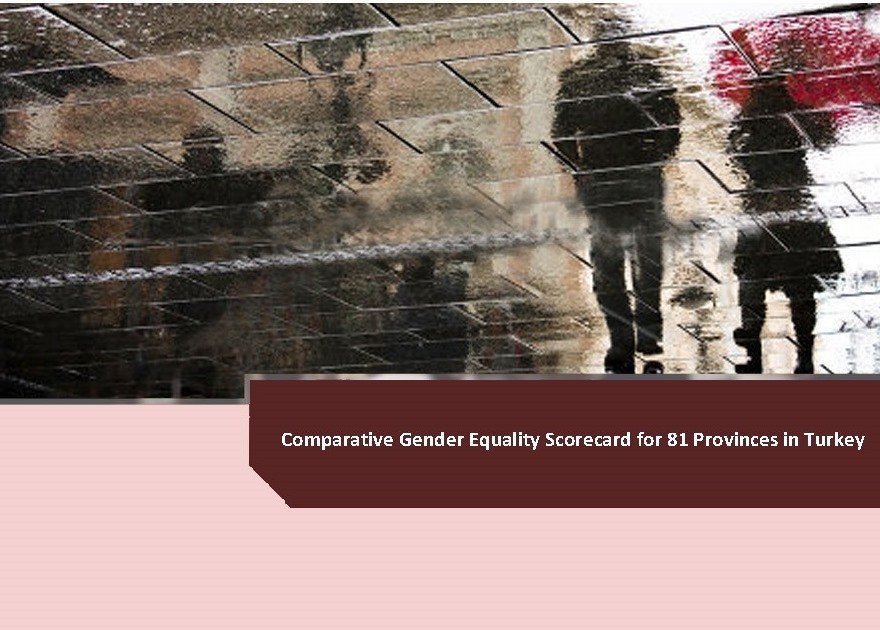
The report entitled “Comparative Gender Equality Scorecard for 81 Cities” has been published. In the context of the study, a Local Gender Equality Index and a Local Gender Empowerment Index were developed and cities were compared on the basis of indicators such as the level of education and services provided for women. The societal gender equality is defined as equal participation, empowerment, representation, and participation in all spheres of the social life without any form of gender discrimination. The TEPAV Gender Equality Report has been constituted by adapting the UN GII to provinces, and respectively ranking the provinces by their inequality levels. In addition to the UN index calculation method of measuring the status of women and men separately, the index of women empowerment has been developed by focusing solely on women’s status while keeping the domains the same.
The report was first published by TEPAV in 2014 to measure gender equality in Turkey at the provincial level and to identify gender equality policies at the national and international level. The study mainly utilized 2011-2012 country wide data and ranked cities according to inequality level. With regard, the second version of the study was reformulated in 2016. This year, using 2017 data, Asmin Kavas, a Research Associate of TEPAV, prepared the Report on “Comparative Gender Equality Scorecard for 81 Cities” by employing similar methods.
Istanbul stands out as the province where women are ranked as the strongest and as the province where the equality between men and women is the best since 2012. In general, indicators show that the economic and social empowerment of women in Turkey has been improving gradually for the last five years.
TEPAV’s 3rd Gender Equality Report
In the previous report generated using the data from 2015, in light of data under four basic indicators: health at the provincial level, ratio of women and men in the municipal council, education, and labor force participation used in the previous report, the cities of Istanbul, Bursa, Eskisehir, Ankara, Muğla, Izmir, Yalova, Bolu, Düzce and Kocaeli come forward as the top 10 equalitarian 10 cities in Turkey. Second inline were Rize, Tekirdağ, Kırklareli, Canakkale, Sinop, Denizli, Sakarya, Aydın, Antalya and Tunceli. In using 2017 data, on the other hand, the top 10 equalitarian cities become Istanbul, Rize, Ankara, Bursa, Tunceli, Bolu, Antalya, Eskisehir, Düzce, and Kocaeli. The second top ten in return were Artvin, Trabzon, Izmir, Tekirdağ, Yalova, Kırklareli, Çanakkale, Sakarya, Sinop and Muğla. The city that attracts attention on the list is Izmir. It ranks in 13th place in 2018 - a drop of 7 places according to 2015 rankings.
According to the study, and following the reports of 2012 and 2016, Istanbul maintains to be in the first in 2018 too. As the results state, the ranking of all cities changed except for Istanbul, Düzce, Kocaeli, Niğde and Yozgat. The cities where the equality gap widened the most according to the earlier report were Bitlis, Mus, Yozgat, Niğde, Afyon, Siirt, Adıyaman, Elazığ, Aksaray and Sivas. The findings of the latest report show that the cities where the equality gap increased are Ağrı, Afyon, Yozgat, Niğde, Mus, Iğdır, Bitlis, Kars, Siirt and, Ardahan, respectively.
Figure 1. The Most Equalitarian Cities in Gender Inequality Index – 2015
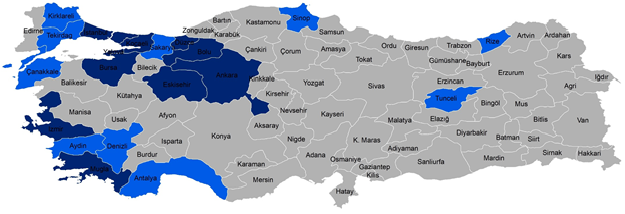
Figure 2. The Most Equalitarian Cities in Gender Inequality Index – 2017
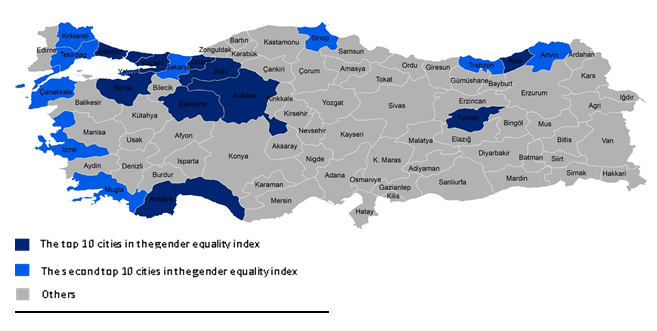
The Impact of “The Representation Rate of Women in the Municipal Council” on the Change of Cities’ Gender Equality Rankings
The differentiation in each of the indicators affects the rankings, but the difference in the representation rates of women in the municipal council appears to be the indicator with the most significant impact. With regard, changes experienced in the indicators of health, education, and labor do not always produce the same impact as changes to the rates of representation of women. Accordingly, to answer the question if the rate of women representation in municipal councils witnessed a decrease or an increase, we analyzed the available data of women’s rate of representation in the councils of 1397 municipalities which consists of 30 metropolitan municipalities, 51 provincial municipalities, 519 province center municipalities, 400 district municipalities, and 397 town municipalities. Furthermore, we contacted the relevant authorities when there was a lack of data on the issue. In accordance with the 2017-2018 findings on rates of women representation the previous results were revised. In relation, the city that was affected the most according to the new findings, compared to the previous reports, was Tunceli. The city managed to narrow down the gender equality gap. As such, Tunceli leaped forward from the 20thplace to the 5th place. While the rise in the rankings is in part due to the positive changes in health, education, and labor indicators - the increase in the rate of women representation in the council appears to have the most positive influence on the results. The gender quality gap, on the other hand, widened in Iğdır, and the city experienced a drop in rankings from the 44th place to the 76th. When we examine Iğdır’s drop in a two-year time span, one reason stand out: the drop in the rate of women representation in the municipal council. Whereas women health and labor indicators enhanced, mind you.
İstanbul: Where Women Are the Strongest
The strongest city according to the female empowerment index, which was put together by ranking women only in terms of empowerment levels and not comparisons to men, was Istanbul in both 2015 and 2017. The rankings of all cities in the new report with regards to women empowerment changed except for Istanbul, Ankara, Antalya, Burdur, Samsun, Diyarbakır, Mardin, and Bingöl.
The top ten provinces where women empowerment was high in 2015’s report were İstanbul, Ankara, Muğla, Izmir, Bursa, Tekirdağ, Antalya, Eskisehir, Tunceli and Kocaeli. According to 2017 findings, İstanbul and Ankara kept the same rankings and Bursa, Kocaeli, Rize, Eskişehir, Kırklareli, Antalya, Bolu and Kırıkkale followed suit respectively. In 2016’s report, the top ten provinces which performed the worst in women’s empowerment index were Muş, Ağrı, Bitlis, Siirt, Yozgat, Şanlıurfa, Adıyaman, Niğde, Şırnak, Afyon, and Aksaray. The worst performing cities shuffled according to 2018 report to become Ağrı, Muş, Yozgat, Afyon, Bitlis, Iğdır, Şanlıurfa, Kars, Siirt, and Adıyaman.
The Impact of “The Representation Rate of Women in the Municipal Council” on the Women’s Empowerment Rankings
A countrywide improvement in Turkey
The work undertaken for this report has showed an improvement in data on the economic and social situation of women in Turkey. However, given the rate of representation of women in social life, the results were not at the desired point. In comparison to 2012 and 2015 results, the gender inequality in Eastern and Southeastern Anatolia regions has narrowed by 2017.
The conclusion of the report emphasizes on the importance of measuring gender equality at the local level, evaluating the results, and developing gender-sensitive social policies to spread the positive effects of gender equality throughout Turkey. To do so, we need to undertake more studies to measure the gender equality at the local level as so to develop gender sensitive social policies that can help transform the local realities. Moreover, these studies require a regular updated to best monitor gender equality and take the relevant precautions.
Table 1. 10 The Most Equalitarian Cities According to Data from 2017
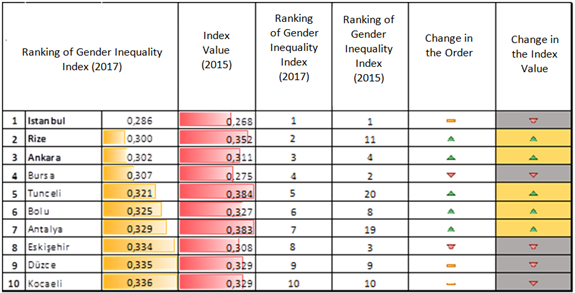
Table 2. 10 The Worst Equalitarian Cities according to Data from 2017
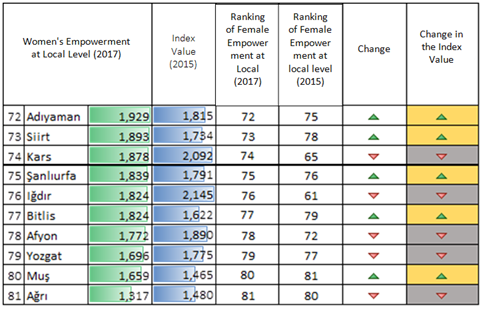
Table 3. 10 Cities Where Women are Most Empowered According to Data from 2017
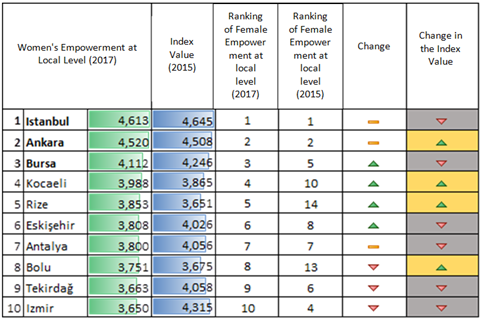
Table 4. 10 Cities Where Women are Least Empowered According to Data from 2017
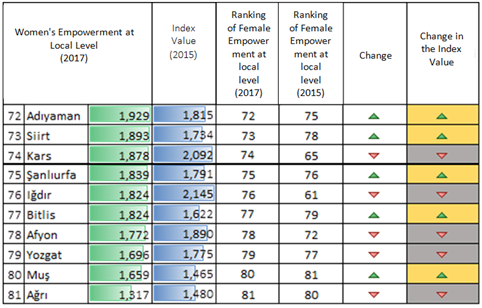
Table 5. 5 Cities that Improved the Most in Societal Gender Inequality Index

Table 6. 5 Cities that Declined the Most in Societal Gender Inequality Index

Table 7. 5 Cities that Improved the Most in Women Empowerment Index

Table 8. 5 Cities that Declined the Most in Women Empowerment Index

- Asmin Kavas,PhD
İlgili Kişiler
« Tüm Haberler
günlük

İmalat Sektörü ve İyi İşler

Enflasyonu düşürmek mi rezervi artırmak mı?












